国内外产业共生网络研究比较述评
赵秋叶,施晓清,*,石 磊
1 中国科学院生态环境研究中心城市与区域生态国家重点实验室, 北京 100085 2 清华大学环境学院国家环境保护生态工业重点实验室,北京 100084
国内外产业共生网络研究比较述评
赵秋叶1,施晓清1,*,石 磊2
1 中国科学院生态环境研究中心城市与区域生态国家重点实验室, 北京 100085 2 清华大学环境学院国家环境保护生态工业重点实验室,北京 100084
产业共生网络是指基于物质及能量交换以及知识及基础设施共享而形成的在不同产业主体之间的合作共赢网络,是产业转型升级的重要保障。作为产业共生的运作方式,产业共生网络的研究国外从20世纪90年代开始从概念到实例就展开了一系列探讨,国内自2002年也开始在网络结构等方面开展相关研究。尤其在2008年以后,产业共生网络的研究方向不断拓宽,研究成果丰富多样。为明晰国内外产业共生网络研究的发展态势,促进产业共生网络理论体系的发展并使其得到有效应用。本文从共生网络内涵、结构、功能及评价、演化、管理调控等方面比较分析了国内外产业共生网络的研究进展,并对产业共生网络的发展前景做了展望。未来产业共生网络研究在不同尺度的比较及推演、数据信息平台的搭建以及产业共生网络演化模拟及管理调控的耦合等方面需重点关注。
产业共生网络;产业共生;网络演化
传统产业发展模式在为人类创造了极大物质文明的同时也带来了严重的生态环境问题,致使全球生态安全受到挑战,区域生态服务受到胁迫,人类健康受到威胁。构建可持续的产业发展模式迫在眉睫。借鉴生态学原理,1989年美国学者Frosch等提出以产业共生为基础的新型产业发展理念,自此引发了产业共生的研究热潮。产业共生是产业生态学中一个重要的研究领域,而产业共生网络是产业共生的内在表现形式,其结构及演化影响整个产业共生体的功效。因此,产业共生网络的研究是当前产业共生领域前沿热点议题,已取得一些重要的研究成果,但缺乏系统的总结以便有效指导实践及辨明未来探索方向。为此,本文利用文献计量学的方法,通过文献筛选分类,从结构、功能、演化及管理等方面系统对比分析了国内外研究的发展进程,并展望了未来研究方向。
1 文献计量研究
1.1 文献筛选及主题分类
检索论文分别选用web of science核心数据库以及中国知网。在Web of Science核心数据库中检索式为(”industrial symbiosis network” OR (“industrial ecology” AND “network”) OR “industrial symbiosis” OR “eco-industrial park*”);在中国知网中检索式为(“产业共生网络”)。筛选流程如图1所示。通过筛选选出111篇中英文文献。不包括以下两大类:第一类是关于网络工程的模型模拟文章(例如水网,电网或者蒸汽网);第二类是描述性的产业共生实践方面的文章。
依据这111篇文献的研究内容将其分为五大主题。1)产业共生网络的内涵界定;2)产业共生网络的结构;3)产业共生网络的功能及评价;4)产业共生网络的演化;5)产业共生网络的管理调控。不同分类主题可能包含同一篇文章。从图2中可以看出,国内外产业共生网络研究内容侧重有所不同,国外偏重对产业共生网络概念和演化。国外学者更加注重产业共生网络演化方面的研究。而中国在产业共生网络结构研究上占有较大份额,在其他方面都略有涉及。
1.2 产业共生网络主题演变
1947年学者Renner通过产业之间的有机联系发现了存在于产业系统内的“产业共生”现象[1],使之开始受到关注。直到1989年Frosch等正式从产业生态系统角度提出产业共生网络的构想[2],产业生态学成为一个新的研究领域被学者注意并开始研究。1997年Kassinis在他的博士论文中讨论公司合作网络将会带来重要经济和环境效益[3]。2000年Chertow的《产业共生:文献和分类》发表,她明确提出了产业共生的概念[4],继而产业共生这一研究方向开始受到广泛关注。
自2000年以后国内外对于产业共生网络的代表性研究逐渐增加,从图3可以看出,尤其是2009年之后,关于产业共生网络的代表性研究从每年5篇左右增至每年10篇以上(2011年除外),相关研究方向不断拓展。但国内外各自增长规律不同,国外产业共生网络研究增长的分水岭在2008,而国内在2011年之后才有明显的增长趋势。从图4可以看出,产业共生网络概念研究一直受到关注,并且经过一段时间的研究实践就会提出新的概念内涵,例如2000年、2005年以及2012年都有产业共生的新的概念提出。产业共生网络结构、功能与评价和演化研究在2009年之后有显著增加。而管理调控方面在不同年份研究数量变化不大。

图1 中英文文献筛选流程图Fig.1 Literature Clean Process

图2 产业共生网络研究主题文章数量 Fig.2 Article number of different area of industrial symbiosis netwo
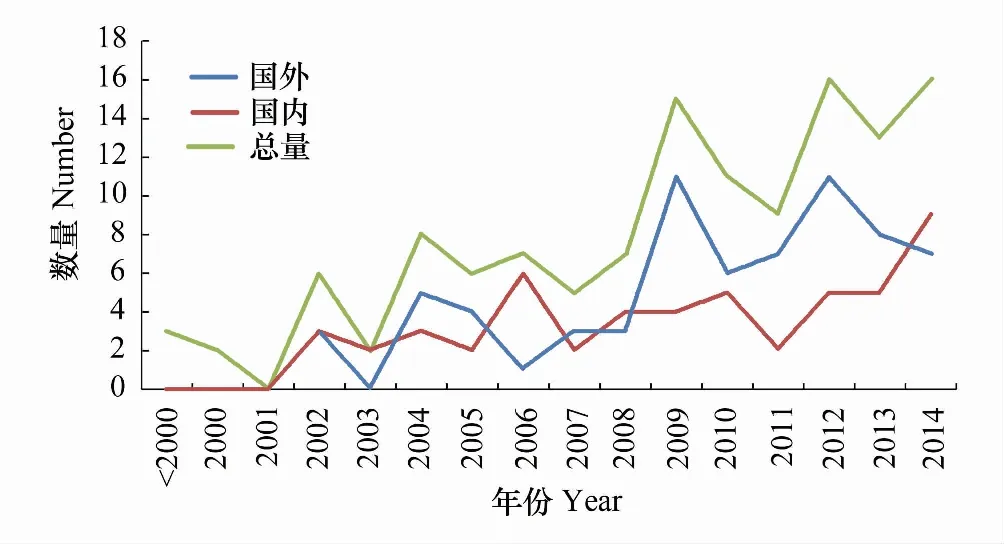
图3 每年国内外发表产业共生网络文献数量 Fig.3 The number of industrial symbiosis network literatures in different year

图4 产业共生网络各研究领域发文章数(2014年以前)Fig.4 Article number of different area of industrial symbiosis network (Before 2014)
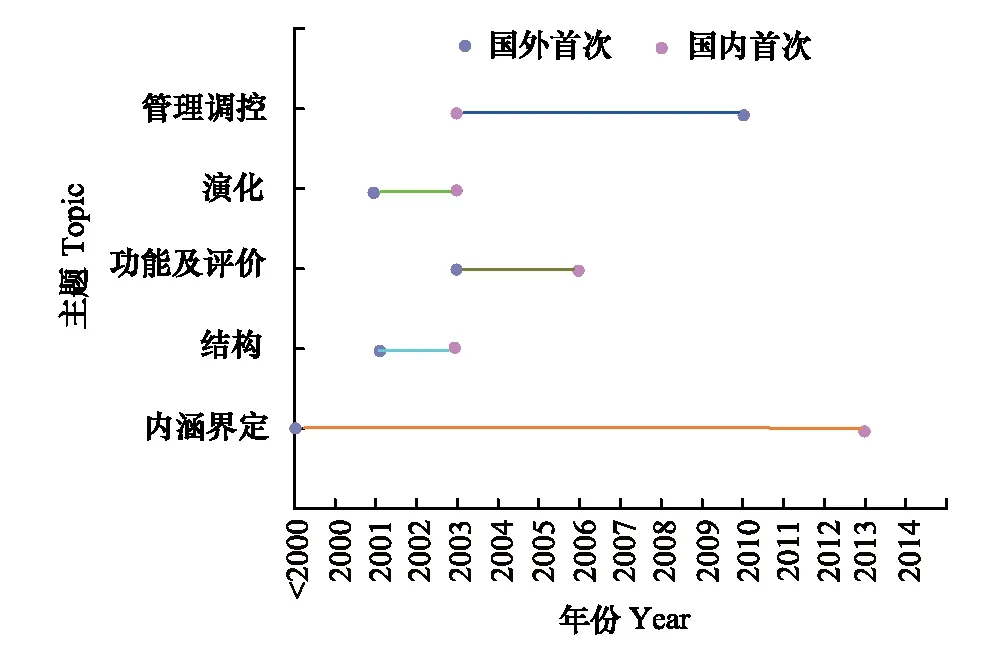
图5 产业共生网络各研究方向国内外首次发文时间 Fig.5 The first published paper in different industrial symbiosis network fields
国内外展开产业共生网络各个主题研究的时间各有不同,从图5可以看出产业共生网络的内涵最早由国外提出,并且国内到2014年才有代表性文章发在中文期刊上,可见国内对于内涵理论的研究滞后于国外。国外在产业共生网络结构、功能与评价以及演化方面研究也早于国内。在产业共生网络管理与调控方面,国内首次发文时间比国外早7a。总体来讲,尽管在多数研究领域国内首次时间晚于国外,但是随后这些领域研究在国内也受到重视,并且在管理调控方面国内研究要早于国外。
2 国内外研究进展
2.1 产业共生网络的内涵界定
1879年德国生物学家德贝里发现自然界中物种之间的共生关系[5]。一百多年后,从Frosch和Gallopoulos[1]、Chertow[4]提出的基于物质及能量交换的产业共生,到Mirata[6]和Lombardi[7]提出的基于知识、人力资源及技术交换的产业共生,再到Boons[8]提出的基于副产品交换及基础设施共享动态产业共生网络,产业共生网络的内涵随着学者对产业共生认识的逐步深入而外延(表1)。国内学者石磊根据国内外研究,也对产业共生进行界定(表1)[9]。
产业共生网络作为产业共生的运作模式,其内涵常隐含在产业共生的定义之中。产业共生的交换或者共享要素包含两大类,一类是物质性要素,另一类是非物质性要素。物质性要素包含产品(存在一定争议)、副产品、废物以及基于资源共享的基础设施;非物质性要素包含服务、信息、知识和技术。事实上,不同的交换要素构成不同类型的产业共生网络,这些不同交换要素构成的产业共生网络相互作用形成了复杂的但完整的产业共生网络。因此,可以认为产业共生网络是指通过物质、能量、产品、副产品、废弃物、知识、人力资源及技术之间的交换以及基础设施的共享等行为,使各合作产业主体获得各自的经济、环境或者社会收益而形成的合作共赢网络。
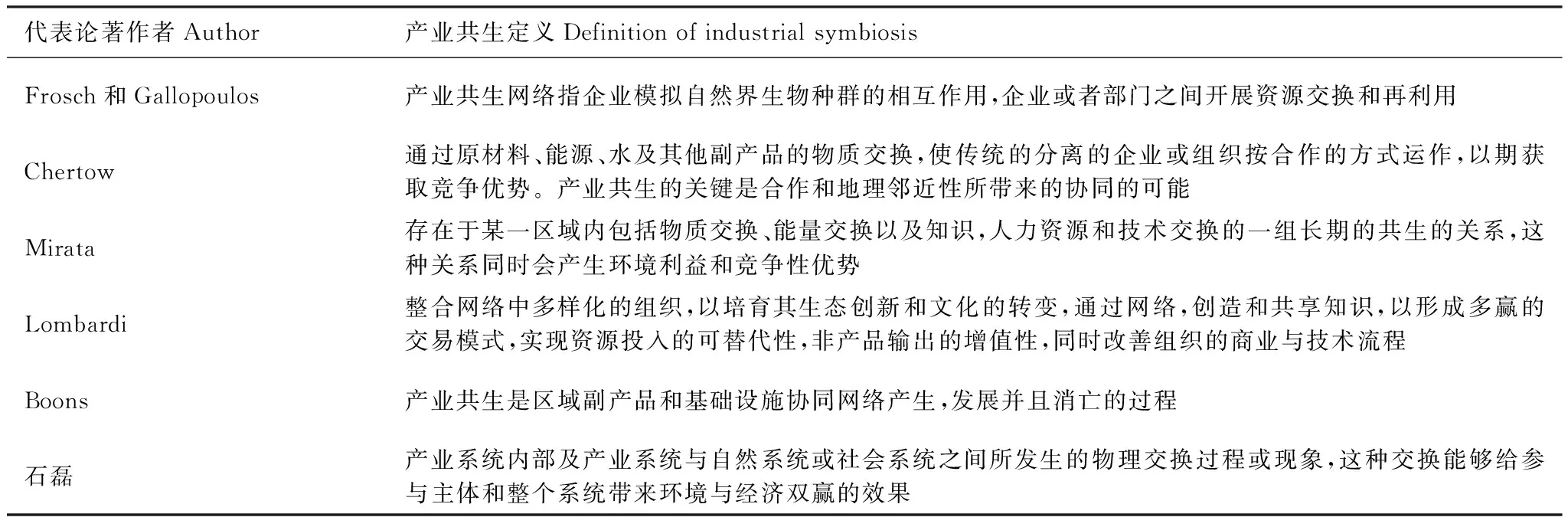
表1 产业共生网络定义变化过程
2.2 产业共生网络的结构
国外主要从网络组织模式及网络结构量化指标两方面展开研究,Chertow[4]最先提出5种不同网络组织模式,Lambert[10]和Wells[11]也提出各自划分方法和依据(表2)。
Ashton结合社会网络理论、自然生态系统理论以及复杂网络理论分析产业共生网络结构化指标,包括节点的数量、分布和类型,节点的中心度,网络弹性等指标[15- 16]。Van berkel也结合网络分析方法提出网络结构量化指标,包括共生网络连接度和共生密度[17]。
国内开展了借鉴自然生态系统食物网和食物链对产业生态系统组分的分析[18-20]。此外比较有特色的是李昆2009借助“生物生态位”理论对生态产业园共生网络中企业生态位进行测度,进而识别该网络中的关键企业[21]。
在结构分析方面,国内学者主要应用社会网络分析,生态网络分析这两大方法展开了园区尺度及城市尺度的产业共生网络的结构分析,研究结果及各方法优劣见表3。

表3 国内产业共生网络结构分析
2.3 产业共生网络的功能及评价
国外对产业共生网络属性的研究主要是从多样性、弹性、连接度、冗余度等方面展开。探讨了产业共生园的连接度、多样性、冗余等属性与自然生态系统的对比以及这些属性与网络弹性的关系[28-30],例如Hardy将食物网理论应用到19个工业园共生网络结构的研究中,计算结果表明产业共生网络的连接度在0.5到0.6之间(典型自然生态系统网络连接度也在这之间);Wright引入生态连接度和生态多样性的概念分析Burnside产业园共生网络Chopra指出设计产业共生网络的过程中,可以通过提高部门多样性和冗余性等措施提高网络的弹性。但是还缺乏系统完整的理论研究。
国内对产业共生网络初期的研究主要是在学习国外产业共生网络基础理论的基础上利用模型等定量化手段分析研究了产业共生网络的弹性、复杂性、稳定性等内在属性(表4)。但是研究还处于百家争鸣的时期,需要进一步统一和完善。

表4 产业共生网络属性研究总结
国内外产业共生网络评价方法见表5。Chertow应用虚拟量化法对美国波多黎各产业共生网络废弃物处理共生和生气系统共生所带来的经济效益和环境效益[45]。随后Jacobsen 2006年用此法对丹麦卡伦堡的整个用水共生系统和蒸汽/热共生系统进行经济效益和环境效益的定量化评价[46]。该法还被用于钢铁行业产业共生的经济效益(表5)评价[47]。
Ometto最早将热力学方法应用到产业共生系统的评价中,他采用火用(emergy)的综合评价方法对社会-生态农业网络共生模型与传统农业系统进行环境和社会效益评价[48]。后续其他学者将热力学方法与其他方法相结合用于共生网络评价(表5)[49- 50]。
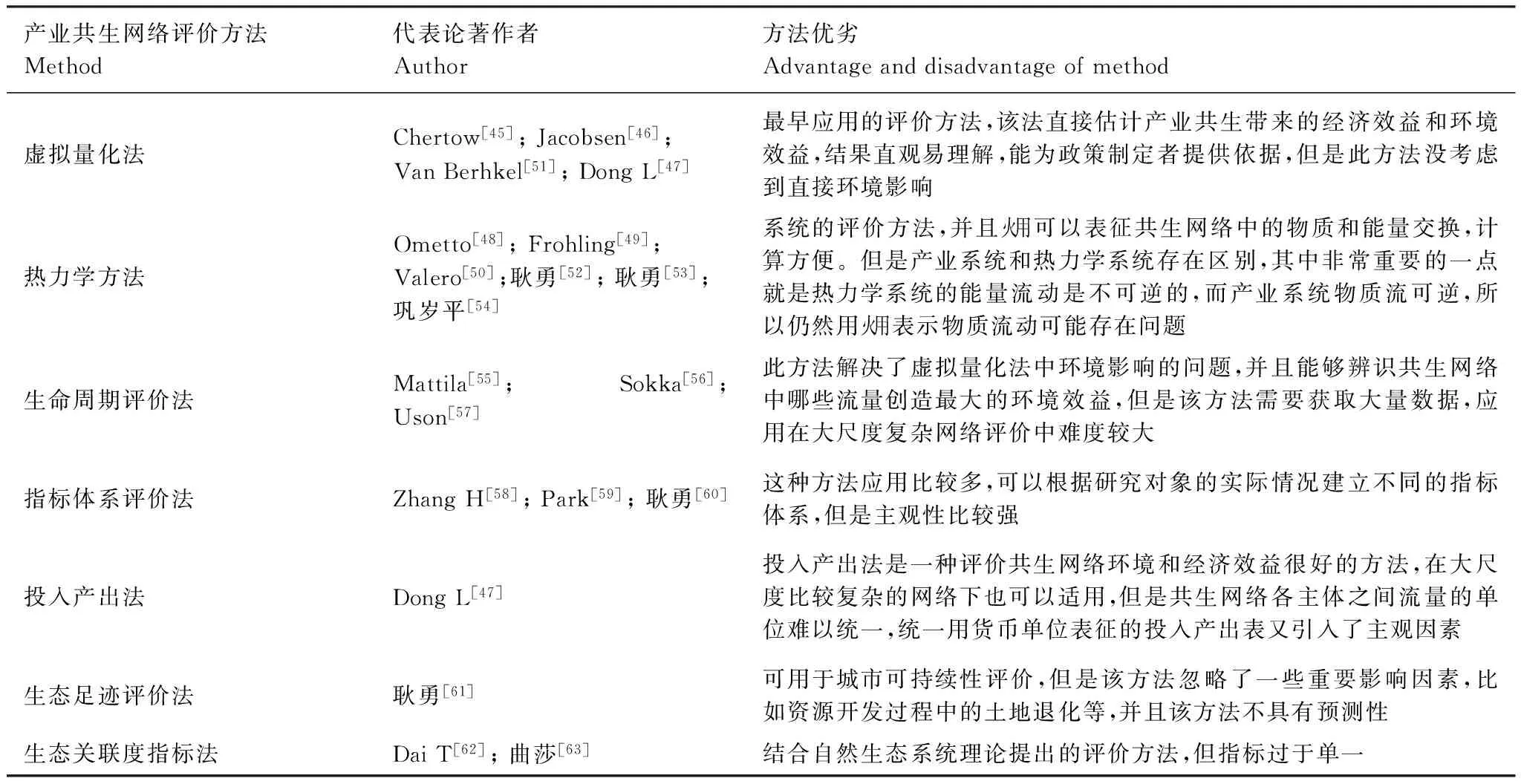
表5 产业共生网络评价方法
生命周期评价法、投入产出法、指标体系法以及也被国外学者用于评价不同尺度上共生网络的表现。Mattila通过过程-生命周期分析法,混合型-生命周期分析法和投入产出-生命周期分析法对产业共生的全部环境效应进行量化并对比并提出自己的建议[96]。Uson年提出用生命周期分析的方法对城市废物处理系统进行环境效益的定量评价[98]。Dong L构建城市尺度的包含能源投入和废物排放的物理和货币混合型投入产出模型用于评估柳州市总的资源消耗和废物排放[89]。Zhang H根据中国循环经济的背景和中国现存的3个用于生态产业园的评价指标体系的内涵提取了对中国生态产业园社会、经济和环境效应定量评价的指标体系[99]。Park用生态效率指标评价产业共生网络的经济和环境表现[100]。
从表5中可以看出,国内主要运用指标体系法进行生态产业园区的评价,如耿勇2008年对中国推出的评价国家生态产业园指标体系进行可行性分析,并指出该标准存在局限性[101];此外,热力学方法和生态足迹评价法也应用到了城市及开发区的产业共生网络的评价中[93- 95]。
表5分析了各种评价方法的优劣,在评价时需要根据数据可获的情况,评价视角,评价内容进行取舍,但每种方法都还有完善的空间。
2.4 产业共生网络的演化
2.4.1 产业共生网络的形成
(1)产业共生网络的形成方式
产业共生网络的形成可总结成3类:自发型,规划型及复合型。一些学者认为自发形成的产业共生网络更加适合生存,特别是辅以积极的政策支持具有更好的可持续性[64- 66]。日本的生态城[51],中国的产业生态园[67],韩国的工业生态园[68]等成功案例也表明了规划型产业共生网络的构建在一定条件下是可行的。Liwarska-Bizukojc[69]提出基于自然生态系统生态关系的模拟生态产业园的概念模型。但对美国可持续发展委员会规划的15个产业共生项目在一段时间内的研究反映了规划型产业共生存在问题[64]。
有学者认为自发行为和非自发行为相结合共同作用促进产业共生网络的形成。如,Paquin提到产业共生网络由自组织及规划而形成,交互作用决定其弹性和稳定性[70]。Costa的“从中间开始(middle-out)”的观点认为自发性的形成和政府等外界的支持共同作用可以促进产业共生网络更好的形成和发展[71]。
(2)产业共生网络的成因
国外学者从多个角度分析产业共生网络形成的原因,包括地理位置,经济效益和环境效益,管理系统或政策作用,知识资源,背景环境,参与主体及交易媒介。具体内容见表6。
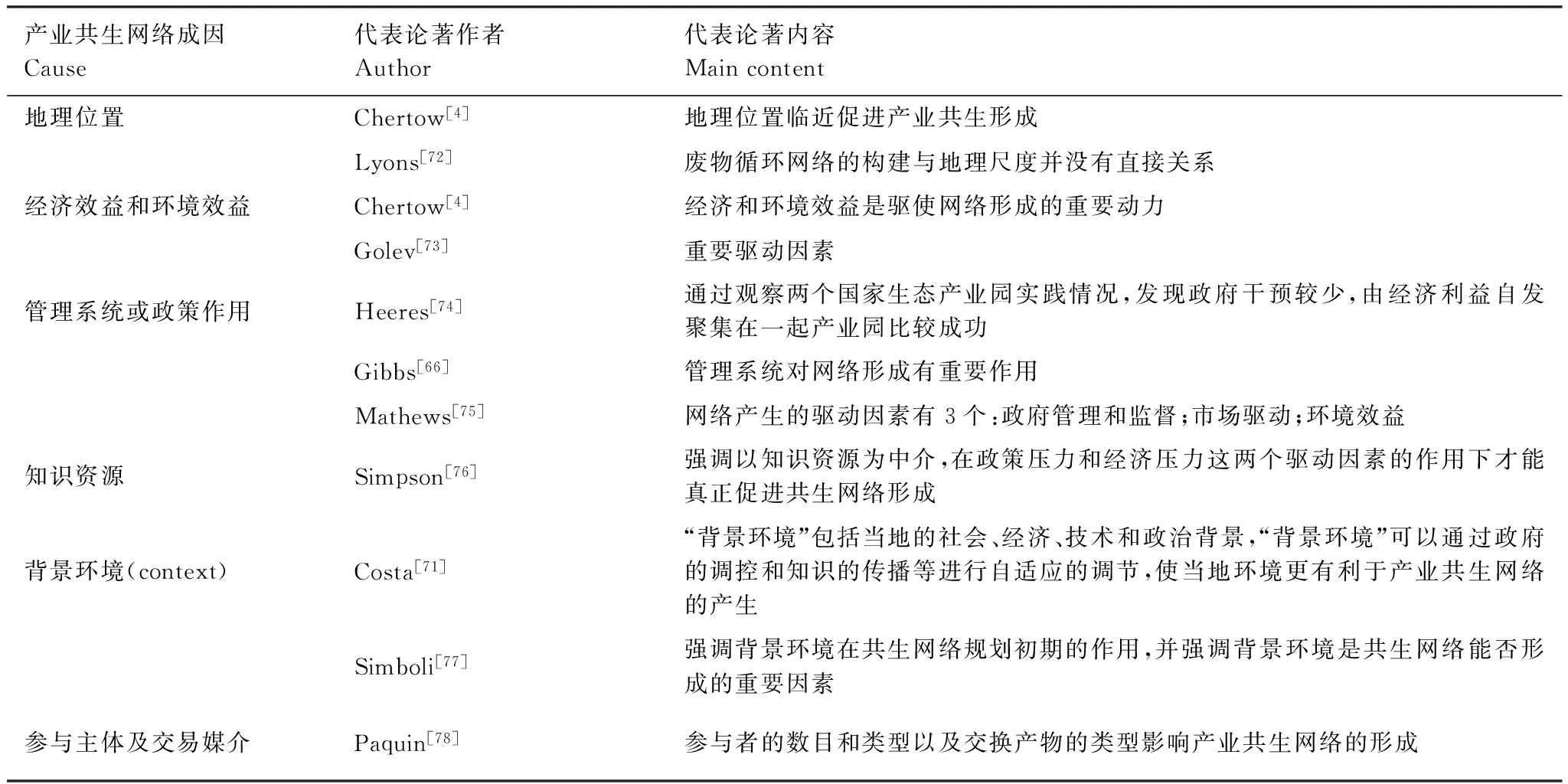
表6 产业共生网络成因归纳
国内王兆华提出产业共生网络的形成机理包括外部机理和内部机理[79]。外部机理包括成本推动、效益拉动和环境取向;内部机理包括复杂系统理论、自组织理论和协同机理。后续有其他学者对其中的一方面进行更加深入的研究。例如杨敬辉[80],蔡小军[34]和李春发[81]从经济学角度剖析产业共生网络的产生机理,都认为追求各方经济利益最大化是产业共生网络产生的重要诱因。袁增伟从企业环境责任入手剖析产业共生网络形成机理,探讨企业环境责任的市场化运作模式及约束机制[82]。刘光富指出城市废弃物资源化共生网络的形成有3种模式,顶层规划形成、自组织形成和政府促进形成[83]。
产业共生的形成方式受时空尺度及政治文化背景等多因素影响,期间的相互作用关系还需进一步研究。另外,城市及国家尺度的产业共生网络的研究也需加强。
2.4.2 产业共生网络的演化
演化是系统发展的轨迹,了解其规律可为管理提供重要的支撑。各学者从不同的视角提出了一些演化模式。从系统的角度分析,Chertow在2012年结合生物学、生态学以及系统论的思想提出产业共生三阶段不连续演进模型——萌芽(Sprouting);显露(Uncovering);制度化(Embeddedness and Institutionalization)[84]。Paquin提出网络演化的3个阶段——交流(Conversation);连通(Connection);共同创造(Co-creation)[70]。Ashton[15]认为Holling提出的复杂系统四阶段演进模型同样适用于产业生态系统,这四个阶段是——占用(Exploitation),保存(Conservation),释放(Release),转移(Mobilisation)[15]。其他学者从不同角度也提出相应的演化模式,Grant[85]从网络信息交流的视角提出了产业共生网络演化阶段的一个范式——机会识别(Opportunity indentification),机会评估(Opportunity assessment),障碍移除(Barrier Removal),商业化和适应性管理(Commercialization and adaptive management),记录和发表(Documentation, review and publication)[85]。Baas基于社会方面的学习的因素提出产业共生网络演化的3个阶段——区域效率(Regional efficiency);区域学习过程(Regional learning);可持续产业共生区域(Sustainable industrial district)[86]。 Domenech从网络成员合作的视角提出演化的3个阶段——出现合作(Emergence),合作关系试用期(Probation),发展并扩大合作关系(Development and expansion)[87]。
国内学者苏敬勤认为不断提高生态效率和固化核心能力是促进产业生态网络演进的两种方式。他提出了基于序参量识别的产业生态系统演进方法,并指出基于生态效率的产业生态网络演进方式向着成员间的纵深方向发展,而基于核心能力的产业生态演进方式则拓展了产业成员间的横向联系[88]。
当前的研究还处于从不同角度研究系统及其子系统的演化规律,还缺乏从方法论上研究符合系统的演化规律。国内在这方面的研究更显不足。
2.4.3 产业共生网络影响因素
产业共生网络演化过程中受到多种要素影响,其类别见表7。
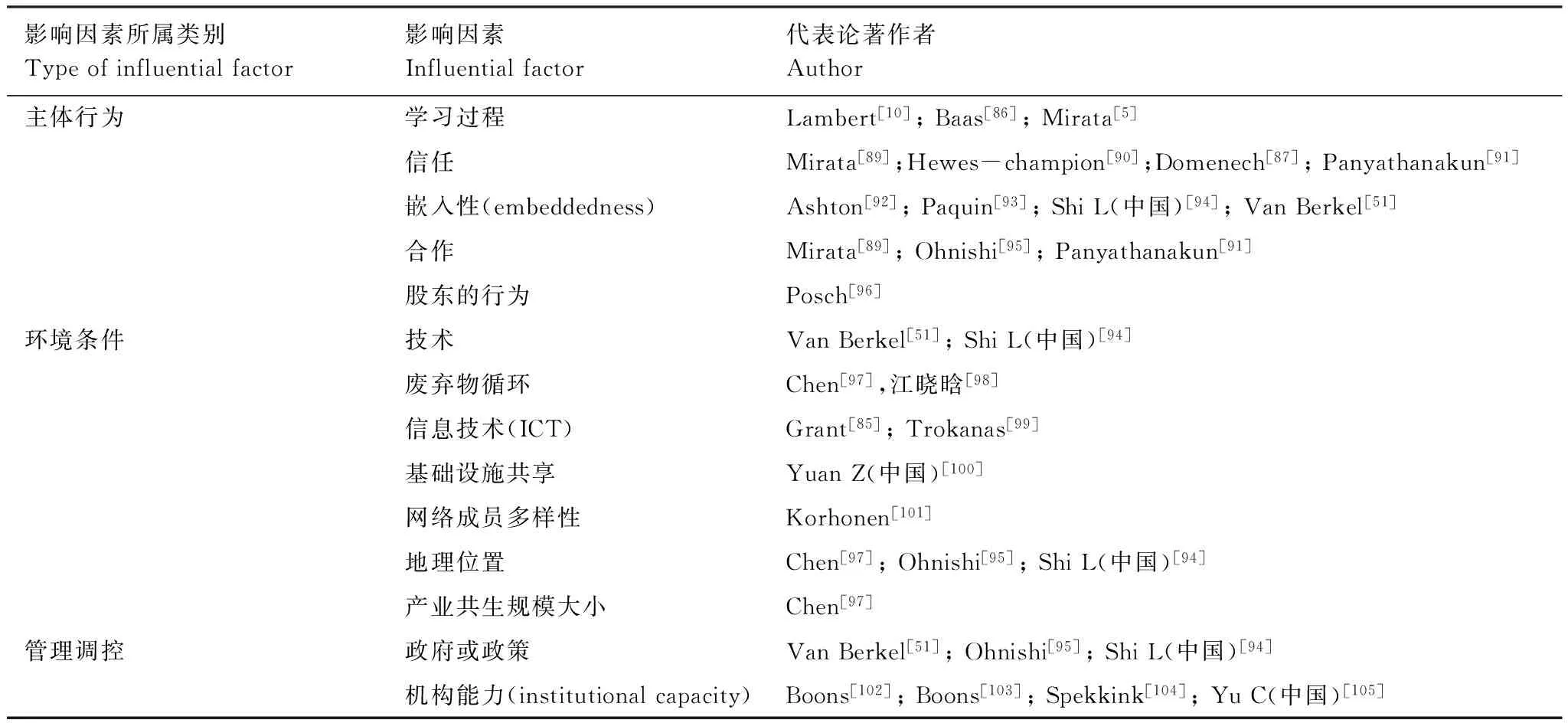
表7 产业共生网络影响因素
信任不仅对产业共生网络的发展有直接的促进作用,正如Domenech[52]所强调的一样,并且Hewes提到领袖人物可以通过促进参与者之间信任的培养促进共生网络发展[71];另外信任还可以通过间接地影响其他因素对产业共生网络的运作产生影响。例如,Panyathanakun强调知识和信任通过决定股东之间的合作,间接影响产业共生网络的发展[91]。
与信任同属于社会范畴的影响因素嵌入性也受到国外学者的重视,事实上这三者在某种程度上有所交叉,包含一些相同的内容。主要研究者Ashton分析不同维度的社会嵌入性(包括结构嵌入性、感知嵌入性和文化嵌入型)与产业共生之间的关系[92]。Paquin也指出嵌入性在产业共生网络演进过程中起着重要作用,无论是结构嵌入性还是文化嵌入性[93]。
Mirata强调合作体(coordination body)对共生网络运行产生重要影响[89]。Ohnishi创新性的用两个多元回归模型定量的研究了影响日本生态城循环项目表现的因素,指出公司之间地理临近以及公司之间合作关系促进循环网络运行效率,政府的资助没有显著影响[95]。
机构能力在近期生态网络发展研究中受到重视。Boons以动态的视角研究产业共生网络发展过程中的内在影响机制,强调区域网络层次机构能力构建和社会网络层次产业共生概念知识传播在网络动态变化过程中的作用[102]。他2012年进一步指出机构能力分为3个维度——关系能力,知识能力和动员能力,对产业共生的发展有复杂的影响[103]。随后,Spekkink用事件序列分析法动态分析机构能力在荷兰地区产业共生演进过程中作用,并且指出机构能力的建立可以通过影响个人的互动,进而促进参与者共同决策,促进区域范围内共生网络的发展[104]。国内Yu C[105]应用过程分析法分析也指出机构能力影响突出[105]。
Grant指出信息与交流工具可以促进隐性知识和显性知识在产业共生网络中的流动,进而促进产业共生网络的运行[85]。Trokanas指出语义网络的建立也会影响产业共生网络的建立和发展过程,该语义网络建立是基于知识模型知识本体特征[99]。
不同学者应用不同方法定性的和定量的研究影响产业共生网络运行的影响因素,国外近年来十分重视社会方面影响因素的研究,国内主要集中在环境和管理方面。但是产业共生网络是涉及到环境、社会等多方面的复杂网络,多因素交叉对产业共生网络运作的影响是未来需要进一步关注的。
2.5 产业共生网络的管理调控
现有的国外研究从模型、指标、基础设施及模式等方面展开管理调控的研究。例如Batten[106],Romero[107]分别提出基于模拟共生网络运作过程的优化管理模型;Cimren创新性提出基于副产品的生态流指标管理方法[108]。Kim提出基于基础设施优化角度优化的产业共生网络管理方法[109];Behera[110]和Short[111]则提出基于商业化优化模式的产业共生网络管理手段。但是当前的研究还很不系统,缺乏不同尺度及复合系统的共生网络管理和调控方法。
国内从全生命周期管理,供应链,环境责任市场化机制及网络均衡模型等方面探讨了产业共生网络管理调控的问题。如朱庆华用生命周期分析与管理以及绿色供应链管理的方法对产业共生网络中的物质和能量流动进行优化[112];袁增伟从产业共生网络的微观要素——企业环境责任入手,开发了基于企业环境责任市场化机制的产业共生网络运营成本模型[113];刘国山建立生态产业共生网络均衡模型,有利于产业共生网络更好的运行[114]。
3 国内外研究总结比较
通过上文国内外研究进展分析,可以看出国内外对产业共生网络的研究侧重点不尽相同,国内外研究的比较具体见表8。
4 问题与展望
4.1 不同研究尺度上的产业共生网络研究
当前大部分产业共生网络演化、结构和评价研究都局限在工业园区尺度,对于城市及区域尺度的研究相对较弱。鉴于各尺度的结构、功能及演化规律的不同,各尺度相关研究及其关系及各尺度的推演研究应是未来研究需要关注的焦点之一。另外,从要素上分析,许多研究从环境及经济上展开了深入研究,国外在社会要素方面也有涉及,但各要素之间的关系及复合影响尚需探讨。此外,对国内来说,社会要素的分析是未来研究需要特别加强的。
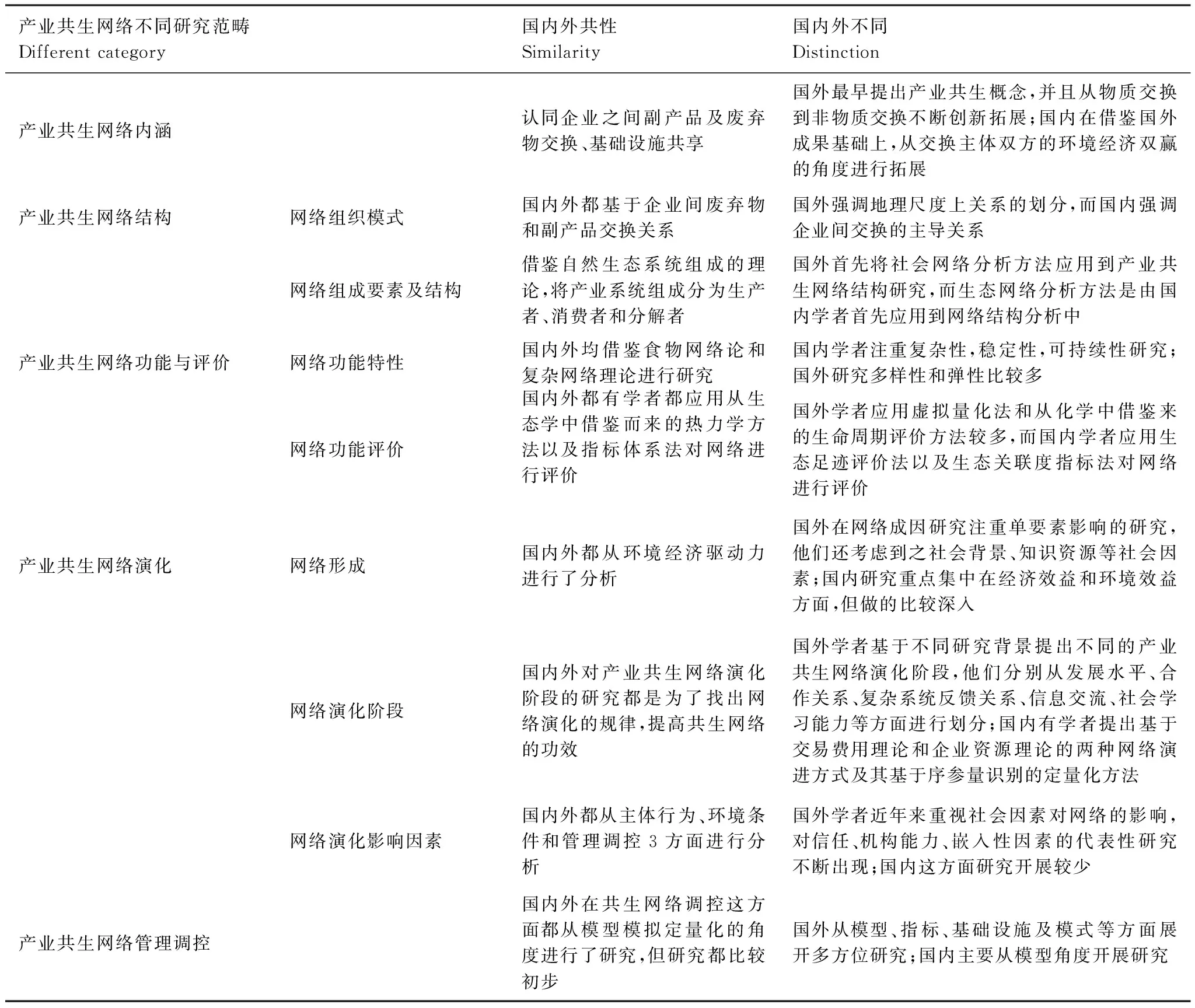
表8 国内外研究比较
4.2 产业共生网络演化模拟及管理调控的耦合
产业共生网络演化规律及其管理的研究是为了有效指导实践。国外已从不同角度展开产业共生网络系统的演化规律的研究,但是尚缺乏从方法论上研究符合系统演化规律的应用模型的探讨,国内在这方面的研究更显不足。因此,建立动态模拟产业共生演化过程模型并将其应用于管理调控应是未来研究需要关注的又一重点。
4.3 共生网络信息平台
定量化方法客观性使其成为研究中的利剑,但需要相关的数据支撑才能发挥其重要作用。而产业共生网络的结构、属性和评价研究中经常会出现数据难以获取或者数据精度低的现象。现实需要一个信息平台保障产业共生网络的发展。产业共生网络实质上是一个包含社会经济环境多组分相互作用形成的复杂网络,其信息量具有大数据的属性,因此其定量化研究及共生网络的发展都需要一个基于数据挖掘功能的大数据信息收集平台支持。因此,基于大数据的信息共享平台也是未来研究的一个重要方向。
5 结论
产业共生网络的研究将为各国产业转型升级促进产业绿色发展,并从资源流疏导增效的角度解决经济发展与环境保护之间的矛盾,实现人类的可持续发展提供重要的理论及方法支撑。未来的研究应在各尺度上面向实践展开理论方法与管理应用相结合的全方位的深入细致研究。
[1] Renner G T. Geography of industrial localization. Economic Geography, 1947, 23(3): 167- 189.
[2] Frosch R A, Gallopoulos N E. Strategies for manufacturing. Scientific American, 1989, 261(3): 144- 152.
[3] Kassinis G I. Industrial reorganization and inter-firm networking in search of environmental co-location economies[D]. Princeton: Princeton University, 1997.
[4] Chertow M R. Industrial symbiosis: literature and taxonomy. Annual Review of Energy and the Environment, 2000, 25: 313- 337.
[5] Ahmdajina V. Symbiosis: An Introduction to Biological Association[M]. England: University press of New England, 1986.
[6] Mirata M, Emtairah T. Industrial symbiosis networks and the contribution to environmental innovation: the case of the Landskrona industrial symbiosis programme. Journal of Cleaner Production, 2005, 13(10/11): 993- 1002.
[7] Lombardi D R, Laybourn P. Redefining industrial symbiosis. Journal of Industrial Ecology, 2012, 16(1): 28- 37.
[8] Boons F, Spekkink W, Jiao W T. A process perspective on industrial symbiosis: theory, methodology, and application. Journal of Industrial Ecology, 2014, 18(3): 341- 355.
[9] 石磊, 刘果果, 郭思平. 中国产业共生发展模式的国际比较及对策. 生态学报, 2012, 32(12): 3950- 3957.
[10] Lambert A J D, Boons F A. Eco-industrial parks: stimulating sustainable development in mixed industrial parks. Technovation, 2002, 22(8): 471- 484.
[11] Wells P, Zapata C. Renewable eco-industrial development: a new frontier for industrial ecology. Journal of Industrial Ecology, 2012, 16(5): 665- 668.
[12] 王兆华, 尹建华. 生态工业园中工业共生网络运作模式研究. 中国软科学, 2005, (2): 80- 85.
[13] 张萌, 姜振寰, 胡军. 工业共生网络运作模式及稳定性分析. 中国工业经济, 2008, (6): 77- 85.
[14] 郭翔, 钟书华. 基于生物种理论的生态工业园区模式. 科技进步与对策, 2006, 23(8): 75- 77.
[15] Ashton W S. The structure, function, and evolution of a regional industrial ecosystem. Journal of Industrial Ecology, 2009, 13(2): 228- 246.
[16] Ashton W. Understanding the organization of industrial ecosystems: a social network approach. Journal of Industrial Ecology, 2008, 12(1): 34- 51.
[17] van Berkel R. Comparability of industrial symbioses. Journal of Industrial Ecology, 2009, 13(4): 483- 486.
[19] 王兆华, 尹建华, 武春友. 生态工业园中的生态产业链结构模型研究. 中国软科学, 2003, (10): 149- 152, 148- 148.
[20] 曲莎, 王京芳, 周浩, 厉秉铎. 生态工业园共生网络的关联度分析. 科技进步与对策, 2009, 26(2): 41- 44.
[21] 李昆, 彭纪生. 基于生态位测度的关键种企业作用前提研究. 中国人口·资源与环境, 2009, 19(4): 129- 133.
[22] 杨丽花, 佟连军. 基于社会网络分析法的生态工业园典型案例研究. 生态学报, 2012, 32(13): 4236- 4245.
[23] Zhang Y, Zheng H M, Chen B, Yang N J. Social network analysis and network connectedness analysis for industrial symbiotic systems: model development and case study. Frontiers of Earth Science, 2013, 7(2): 169- 181.
[24] 唐玲, 孙晓峰, 李键. 生态工业园区共生网络的结构分析: 以天津泰达为例. 中国人口·资源与环境, 2014, 24(S2): 216- 221.
[25] Lu Y, Su M R, Liu G Y, Chen B, Zhou S Y, Jiang M M. Ecological network analysis for a low-carbon and high-tech industrial park. Scientific World Journal, 2012, 2012: 305474.
[26] 刘耕源, 杨志峰, 陈彬, 徐琳瑜, 张妍. 基于生态网络的城市代谢结构模拟研究——以大连市为例. 生态学报, 2013, 33(18): 5926- 5934.
[27] Zhang Y, Zheng H M, Fath B D, Liu H, Yang Z F, Liu G Y, Su M R. Ecological network analysis of an urban metabolic system based on input-output tables: model development and case study for Beijing. Science of the Total Environment, 2014, 468- 469: 642- 653.
[28] Hardy C, Graedel T E. Industrial ecosystems as food webs. Journal of Industrial Ecology, 2002, 6(1): 29- 38.
[29] Wright R A, Cté R P, Duffy J, Brazner J. Diversity and connectance in an industrial context: the case of Burnside industrial park. Journal of Industrial Ecology, 2009, 13(4): 551- 564.
[30] Chopra S S, Khanna V. Understanding resilience in industrial symbiosis networks: insights from network analysis. Journal of Environmental Management, 2014, 141: 86- 94.
[31] 宋雨萌, 石磊. 工业共生网络的复杂性度量及案例分析. 清华大学学报: 自然科学版, 2008, 48(9): 1441- 1444.
[32] 黄训江. 工业共生网络演化的小世界性及稳定性分析. 东北大学学报: 自然科学版, 2011, 32(6): 887- 890.
[33] 周慧, 李健, 宋雅杰. 城市产业共生网络的复杂性与管理模式分析. 地域研究与开发, 2011, 30(3): 35- 38, 43- 43.
[34] 蔡小军, 李双杰, 刘启浩. 生态工业园共生产业链的形成机理及其稳定性研究. 软科学, 2006, 20(3): 12- 14.
[35] 段宁, 邓华, 武春友. 我国生态工业系统稳定性的结构型因素实证研究. 环境科学研究, 2006, 19(2): 57- 61, 81- 81.
[36] 黄志鸿. 生态工业园工业共生网络稳定性研究. 科技和产业, 2006, 6(10): 28- 31.
[37] 张萌. 工业共生网络形成机理及稳定性研究[D]. 哈尔滨: 哈尔滨工业大学, 2008.
[38] Wang G, Feng X, Chu K H. A novel approach for stability analysis of industrial symbiosis systems. Journal of Cleaner Production, 2013, 39: 9- 16.
[39] Zhu L, Zhou J R, Cui Z J, Liu L. A method for controlling enterprises access to an eco-industrial park. Science of the Total Environment, 2010, 408(20): 4817- 4825.
[40] 李湘梅, 肖人彬, 曾宇, 姚智爽. 生态工业园共生网络的脆弱性. 生态学报, 2014, 34(16): 4746- 4755.
[41] Zeng Y, Xiao R B, Li X M. A resilience approach to symbiosis networks of ecoindustrial parks based on cascading failure model. Mathematical Problems in Engineering, 2013, 2013: 372368.
[42] Zhu J M, Ruth M. Exploring the resilience of industrial ecosystems. Journal of Environmental Management, 2013, 122: 65- 75.
[43] Li Y, Shi L. The resilience of interdependent industrial symbiosis networks: a case of Yixing economic and technological development zone. Journal of Industrial Ecology, 2015, 19(2): 264- 273.
[44] Huang J L, Ulanowicz R E. Ecological network analysis for economic systems: growth and development and implications for sustainable development. PLoS One, 2014, 9(6): e100923.
[45] Chertow M R, Lombardi D R. Quantifying economic and environmental benefits of co-located firms. Environmental Science & Technology, 2005, 39(17): 6535- 6541.
[46] Jacobsen N B. Industrial symbiosis in Kalundborg, Denmark: a quantitative assessment of economic and environmental aspects. Journal of Industrial Ecology, 2006, 10(1/2): 239- 255.
[47] Dong L, Zhang H, Fujita T, Ohnishi S, Li H Q, Fujii M, Dong H J. Environmental and economic gains of industrial symbiosis for Chinese iron/steel industry: Kawasaki′s experience and practice in Liuzhou and Jinan. Journal of Cleaner Production, 2013, 59: 226- 238.
[48] Ometto A R, Ramos P A R, Lombardi G. The benefits of a Brazilian agro-industrial symbiosis system and the strategies to make it happen. Journal of Cleaner Production, 2007, 15(13- 14): 1253- 1258.
[49] Fröhling M, Schwaderer F, Bartusch H, Schultmann F. A material flow-based approach to enhance resource efficiency in production and recycling networks. Journal of Industrial Ecology, 2013, 17(1): 5- 19.
[50] Valero A, Usón S, Torres C, Valero A, Agudelo A, Costa J. Thermoeconomic tools for the analysis of eco-industrial parks. Energy, 2013, 62: 62- 72.
[51] Van Berkel R, Fujita T, Hashimoto S, Geng Y. Industrial and urban symbiosis in Japan: analysis of the eco-town program 1997- 2006. Journal of Environmental Management, 2009, 90(3): 1544- 1556.
[52] Geng Y, Zhang P, Ulgiati S, Sarkis J. Emergy analysis of an industrial park: the case of Dalian, China. Science of the Total Environment, 2010, 408(22): 5273- 5283.
[53] Geng Y, Liu Z X, Xue B, Dong H J, Fujita T, Chiu A. Emergy-based assessment on industrial symbiosis: a case of Shenyang economic and technological development zone. Environmental Science and Pollution Research, 2014, 21(23): 13572- 13587.
[54] 巩岁平, 任军号, 张宝磊. 基于能值分析的工业共生网络评价. 科技管理研究, 2010, 30(23): 34- 37.
[55] Mattila T J, Pakarinen S, Sokka L. Quantifying the total environmental impacts of an industrial symbiosis-a comparison of process-, hybrid and input-output life cycle assessment. Environmental Science & Technology, 2010, 44(11): 4309- 4314.
[56] Sokka L, Lehtoranta S, Nissinen A, Melanen M. Analyzing the environmental benefits of industrial symbiosis: life cycle assessment applied to a Finnish forest industry complex. Journal of Industrial Ecology, 2011, 15(1): 137- 155.
[57] Usón A A, Ferreira G, Vásquez D Z, Bribián I Z, Sastresa E L. Environmental-benefit analysis of two urban waste collection systems. Science of the Total Environment, 2013, 463- 464: 72- 77.
[58] Zhang H Y, Hara K, Yabar H, Yamaguchi Y, Uwasu M, Morioka T. Comparative analysis of socio-economic and environmental performances for Chinese EIPs: case studies in Baotou, Suzhou, and Shanghai. Sustainability Science, 2009, 4(2): 263- 279.
[59] Park H S, Behera S K. Methodological aspects of applying eco-efficiency indicators to industrial symbiosis networks. Journal of Cleaner Production, 2014, 64: 478- 485.
[60] Geng Y, Zhang P, Cté R P, Qi Y. Evaluating the applicability of the Chinese eco-industrial park standard in two industrial zones. International Journal of Sustainable Development & World Ecology, 2008, 15(6): 543- 552.
[61] Geng Y, Zhang L M, Chen X D, Xue B, Fujita T, Dong H J. Urban ecological footprint analysis: a comparative study between Shenyang in China and Kawasaki in Japan. Journal of Cleaner Production, 2014, 75: 130- 142.
[62] Dai T J. Two quantitative indices for the planning and evaluation of eco-industrial parks. Resources, Conservation and Recycling, 2010, 54(7): 442- 448.
[63] 曲莎, 王京芳, 厉秉铎. 基于关联度分析的生态工业园共生网络评价. 科学学与科学技术管理, 2007, 28(10): 36- 40.
[64] Chertow M R. “Uncovering” industrial symbiosis. Journal of Industrial Ecology, 2007, 11(1): 11- 30.
[65] Desrochers P. Industrial symbiosis: the case for market coordination. Journal of Cleaner Production, 2004, 12(8/10): 1099- 1110.
[66] Gibbs D, Deutz P. Reflections on implementing industrial ecology through eco-industrial park development. Journal of Cleaner Production, 2007, 15(17): 1683- 1695.
[67] Zhu Q H, Lowe E A, Wei Y A, Barnes D. Industrial symbiosis in China: a case study of the Guitang Group. Journal of Industrial Ecology, 2007, 11(1): 31- 42.
[68] Park H S, Rene E R, Choi S M, Chiu A S F. Strategies for sustainable development of industrial park in Ulsan, South Korea-from spontaneous evolution to systematic expansion of industrial symbiosis. Journal of Environmental Management, 2008, 87(1): 1- 13.
[69] Liwarska-Bizukojc E, Bizukojc M, Marcinkowski A, Doniec A. The conceptual model of an eco-industrial park based upon ecological relationships. Journal of Cleaner Production, 2009, 17(8): 732- 741.
[70] Paquin R L, Howard-Grenville J. The evolution of facilitated industrial symbiosis. Journal of Industrial Ecology, 2012, 16(1): 83- 93.
[71] Costa I, Ferrão P. A case study of industrial symbiosis development using a middle-out approach. Journal of Cleaner Production, 2010, 18(10/11): 984- 992.
[72] Lyons D I. A spatial analysis of loop closing among recycling, remanufacturing, and waste treatment firms in Texas. Journal of Industrial Ecology, 2007, 11(1): 43- 54.
[73] Golev A, Corder G D. Developing a classification system for regional resource synergies. Minerals Engineering, 2012, 29: 58- 64.
[74] Heeres R R, Vermeulen W J V, de Walle F B. Eco-industrial park initiatives in the USA and the Netherlands: first lessons. Journal of Cleaner Production, 2004, 12(8/10): 985- 995.
[75] Mathews J A, Tan H. Progress toward a circular economy in China: the drivers (and inhibitors) of eco-industrial initiative. Journal of Industrial Ecology, 2011, 15(3): 435- 457.
[76] Simpson D. Knowledge resources as a mediator of the relationship between recycling pressures and environmental performance. Journal of Cleaner Production, 2012, 22(1): 32- 41.
[77] Simboli A, Taddeo R, Morgante A. Analysing the development of industrial symbiosis in a motorcycle local industrial network: the role of contextual factors. Journal of Cleaner Production, 2014, 66: 372- 383.
[78] Paquin R L, Tilleman S G, Howard-Grenville J. Is there cash in that trash?: factors influencing industrial symbiosis exchange initiation and completion. Journal of Industrial Ecology, 2014, 18(2): 268- 279.
[79] 王兆华. 生态工业园工业共生网络研究[D]. 大连: 大连理工大学, 2002.
[80] 杨敬辉, 武春友, 张文博. 试用外部性理论分析生态工业园的经济学机制. 中国资源综合利用, 2004, (4): 30- 33.
[81] 李春发, 李萌萌, 王强, 王向丽. 生态工业共生网络中利益相关者关系研究. 软科学, 2012, 26(12): 5- 9.
[82] 袁增伟, 毕军. 生态产业共生网络形成机理及其系统解析框架. 生态学报, 2007, 27(8): 3182- 3188.
[83] 刘光富, 鲁圣鹏, 李雪芹, 陈洋琴. 废弃物资源化城市共生网络形成模式研究. 科技进步与对策, 2014, 31(12): 36- 40.
[84] Chertow M, Ehrenfeld J. Organizing self-organizing systems. Journal of Industrial Ecology, 2012, 16(1): 13- 27.
[85] Grant G B, Seager T P, Massard G, Nies L. Information and communication technology for industrial symbiosis. Journal of Industrial Ecology, 2010, 14(5): 740- 753.
[86] Baas L W, Boons F A. An industrial ecology project in practice: exploring the boundaries of decision-making levels in regional industrial systems. Journal of Cleaner Production, 2004, 12(8/10): 1073- 1085.
[87] Doménech T, Davies M. The role of embeddedness in industrial symbiosis networks: phases in the evolution of industrial symbiosis networks. Business Strategy and the Environment, 2011, 20(5): 281- 296.
[88] 刁晓纯, 苏敬勤. 基于序参量识别的产业生态网络演进方式研究. 科学学研究, 2008, 26(3): 506- 510.(请核对序号89,90)
[89] Mirata M. Experiences from early stages of a national industrial symbiosis programme in the UK: determinants and coordination challenges. Journal of cleaner production, 2004, 12(8/10): 967-983
[90] Hewes A K, Lyons D I. The humanistic side of eco-industrial parks: champions and the role of trust. Regional studies, 2008, 42(10): 1329-1342
[91] Panyathanakun V, Tantayanon S, Tingsabhat C, Charmondusit K. Development of eco-industrial estates in Thailand: initiatives in the northern region community-based eco-industrial estate. Journal of Cleaner Production, 2013, 51: 71- 79.
[92] Ashton W S, Bain A C. Assessing the “short mental distance” in eco-industrial networks. Journal of Industrial Ecology, 2012, 16(1): 70- 82.
[93] Paquin R L, Howard-Grenville J. The evolution of facilitated industrial symbiosis. Journal of Industrial Ecology, 2012, 16(1): 83- 93.
[94] Shi L, Yu B. Eco-industrial parks from strategic niches to development mainstream: the cases of China. Sustainability, 2014, 6(9): 6325-6331
[95] Ohnishi S, Fujita T, Chen X D, Fujii M. Econometric analysis of the performance of recycling projects in Japanese eco-towns. Journal of cleaner production, 2012, 33: 217-225
[96] Posch A. Industrial recycling networks as starting points for broader sustainability-oriented cooperation? Journal of industrial ecology, 2010, 14(2): 242-257
[97] Chen X D, Fujita T, Ohnishi S, Geng Y. The impact of scale, recycling boundary, and type of waste on symbiosis and recycling. Journal of industrial ecology, 2012, 16(1): 129-141
[98] 江晓晗,郭涛,任晓璐. 生态工业园共生网络及其治理研究. 生态经济, 2014, 7: 101-106
[99] Trokanas N, Cecelja F, Raafat T. Semantic input/output matching for waste processing iin industrial symbiosis. Computers& Chemical engineering, 2014, 66: 259-268
[100] Yuan Z, Zhang L, Zhang B, Huang L, Bi J, Liu B. Improving competitive advantage with environmental infrastructure sharing: a case study of China- Singapore Suzhou industrial park. International journal of environmental research, 2010, 4(4): 751-758[101] Korhonen J, Snakin J P. Analysing the evolution of industrial ecosystems: concepts and application. Ecological economics, 2005, 52(2): 169-186
[102] Boons F, Spekkink W, Mouzakitis Y. The dynamics of industrial symbiosis: a proposal for a conceptual framework based upon a comprehensive literature review. Journal of Cleaner Production, 2011, 19(9/10): 905- 911.
[103] Boons F, Spekkink W. Levels of institutional capacity and actor expectations about industrial symbiosis. Journal of Industrial Ecology, 2012, 16(1): 61- 69.
[104] Spekkink W. Institutional capacity building for industrial symbiosis in the Canal Zone of Zeeland in the Netherlands: a process analysis. Journal of Cleaner Production, 2013, 52: 342- 355.
[105] Yu C, de Jong M, Dijkema G P J. Process analysis of eco-industrial park development-the case of Tianjin, China. Journal of Cleaner Production, 2014, 64: 464- 477.
[106] Batten D F. Fostering industrial symbiosis with agent-based simulation and participatory modeling. Journal of Industrial Ecology, 2009, 13(2): 197- 213.
[107] Romero E, Ruiz M C. Framework for applying a complex adaptive system approach to model the operation of eco-industrial parks. Journal of Industrial Ecology, 2013, 17(5): 731- 741.
[108] Cimren E, Fiksel J, Posner M E, Sikdar K. Material flow optimization in by-product synergy networks. Journal of Industrial Ecology, 2011, 15(2): 315- 332.
[109] Kim S H, Yoon S G, Chae S H, Park S. Economic and environmental optimization of a multi-site utility network for an industrial complex. Journal of Environmental Management, 2010, 91(3): 690- 705.
[110] Behera S K, Kim J H, Lee S Y, Suh S, Park H S. Evolution of ‘designed’ industrial symbiosis networks in the Ulsan Eco-industrial park: ‘research and development into business’ as the enabling framework. Journal of Cleaner Production, 2012, 29- 30: 103- 112.
[111] Short S W, Bocken N M P, Barlow C Y, Chertow M R. From refining sugar to growing tomatoes: industrial ecology and business model evolution. Journal of Industrial Ecology, 2014, 18(5): 603- 618.
[112] Zhu Q H, Cote R P. Integrating green supply chain management into an embryonic eco-industrial development: a case study of the Guitang Group. Journal of Cleaner Production, 2004, 12(8/10): 1025- 1035.
[113] 袁增伟, 毕军. 生态产业共生网络运营成本及其优化模型开发研究. 系统工程理论与实践, 2006, 26(7): 92- 97, 123- 123.
[114] 刘国山, 徐士琴, 孙懿文, 韩继业. 生态产业共生网络均衡模型. 北京科技大学学报, 2013, 35(9): 1221- 1229.
A review of the industrial symbiosis network
ZHAO Qiuye1, SHI Xiaoqing1,*, SHI Lei2
1StateKeyLaboratoryofUrbanandRegionalEcology,ResearchCenterforEco-EnvironmentalScience,ChineseAcademyofScience,Beijing100085,China2StateEnvironmentalProtectionKeyLaboratoryofEco-industry,SchoolofEnvironment,TsinghuaUniversity,Beijing100084,China
Although traditional industrial development has created great wealth for human beings, it has caused serious eco-environmental problems, which have challenged global eco-security, resulting in regional eco-service crises and threatening human health. It is fundamental to develop a sustainable industrial developmental model to reverse this dangerous trend. An industrial symbiosis-based model was developed in 1989 to enhance industry ecosystems, which provided new ideas to solve the problem. The industrial symbiosis network is a cooperative network between different companies based on the exchange of material, energy, knowledge, fundamental infrastructure, and services that benefits all parts of the network; and this system has been considered since the 1990s. As it necessary to maintain the efficacy of industrial symbiosis, research has been carried out globally from theory to practice on the industrial symbiosis network since 1989. Moreover, research has been conducted in China to study network structure since 2002. From 2008, extensive research has focused on different areas of the industrial symbiosis network, to summarize existing research, clarify future directions, and facilitate application. The present article reviews the literature related to the industrial symbiosis network from five different areas: definition, structure, function and assessment, evolution, and management. This article concludes that global research has focused on the industrial symbiosis network theory, evolution, and assessment, and the factors affecting it. However, Chinese research has focused on the structure and attributes of industrial symbiosis. In addition, some global research has focused on the social factors that influence the evolution of the industrial symbiosis network, which was neglected before 2009. Moreover, local research has focused on industrial symbiosis on an urban scale. Furthermore, there are three topics that should be highlighted in future research: First, it is important to understand different scales of the industrial symbiosis network, as urban and regional-scale network research is limited. In addition, multiple factors that influence the evolution of the industrial symbiosis network should be discussed. Furthermore, Chinese research should focus on social factors. Second, it is fundamental to quantitatively clarify the industrial symbiosis network, which depends on sufficient support from relevant data. Therefore, a digital information platform should be developed to satisfy the requirement of the large amounts of accurate data required for such research. Third, different scientific models should be developed to study the evolution of the industrial symbiosis network for its effective management. Therefore, industrial symbiosis has been become a potential method to promote the green development of various industries, and to ensure economic development and effective environmental protection.
industrial symbiosis network; industrial symbiosis; evolution of industrial symbiosis network
国家自然科学基金资助项目(71373259, 71173208)
2015- 07- 30;
2016- 03- 22
10.5846/stxb201507301598
*通讯作者Corresponding author.E-mail: shixq@rcees.ac.cn
赵秋叶,施晓清,石磊.国内外产业共生网络研究比较述评.生态学报,2016,36(22):7288- 7301.
Zhao Q Y, Shi X Q, Shi L.A review of the industrial symbiosis network.Acta Ecologica Sinica,2016,36(22):7288- 7301.

